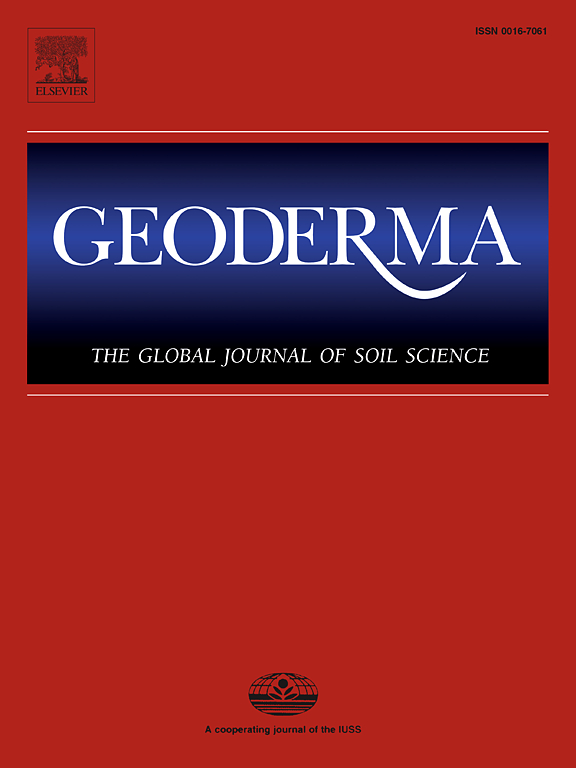Predicting soil organic matter using corrected field spectra and stacking ensemble learning
IF 6.6
1区 农林科学
Q1 SOIL SCIENCE
引用次数: 0
Abstract
Soil organic matter (SOM), as a key indicator of soil fertility and the carbon cycle, its field rapid and precise quantification is of great scientific significance for precise agricultural management. Visible near-infrared (Vis-NIR) spectroscopy technology is a rapid and highly accurate SOM quantification method. While the laboratory spectra measurement requires a series of processing procedures. Compared with laboratory spectra, field spectra measurement has the advantages of being faster and more convenient. However, achieving high-precision estimation of SOM based on field spectra poses significant challenges, primarily in mitigating the effects of interfering factors, such as soil moisture and developing a highly robust spectra prediction model. In the practical application of field spectroscopy, eliminating interference through spectra correction methods is an effective strategy. The field prediction of SOM using spectra correction algorithms in conjunction with ensemble learning remains a significant and unresolved challenge. In this study, we gathered 180 soil samples from Hancheng City, Shaanxi Province, China, and built Stacking models using field spectra, field corrected spectra, and lab spectra, respectively, and comprehensively compared their predictive abilities. The study aims to assess the ability of spectra correction methods, including non-negative matrix decomposition (NMF), and generalized least squares weight (GLSW), when combined with the Stacking model, to predict SOM. The results showed that it was difficult challenging to accurately predict SOM using models calibrated with field spectra. However, spectra data corrected by NMF and GLSW could effectively mitigate the influence of environmental interference factors and significantly enhance the model’s predictive performance. The GLSW (R2 = 0.85, RMSE = 3.74 g kg−1) outperformed the NMF method (R2 = 0.69, RMSE = 5.14 g kg−1) and was close to the laboratory spectra model (R2 = 0.89, RMSE = 3.81 g kg−1). Combining spectra correction and stacking improves field SOM prediction accuracy, increasing R2 value by 0.1 and 0.26, and decreasing RMSE by 1.16 and 2.56 g kg−1. The performance of all Stacking models was superior to that of the best single model. The stacking model could effectively improve the accuracy of SOM model.
利用校正场光谱和叠加系综学习预测土壤有机质
土壤有机质(SOM)作为土壤肥力和碳循环的关键指标,其田间快速、精确量化对精准农业管理具有重要的科学意义。可见近红外(Vis-NIR)光谱技术是一种快速、高精度的SOM定量方法。而实验室光谱测量需要一系列的处理程序。与实验室光谱相比,现场光谱测量具有更快、更方便的优点。然而,实现基于现场光谱的SOM高精度估计面临着重大挑战,主要是在减轻干扰因素的影响,如土壤湿度和开发高度鲁棒的光谱预测模型。在现场光谱的实际应用中,通过光谱校正方法消除干扰是一种有效的策略。利用光谱校正算法结合集成学习进行SOM的现场预测仍然是一个重大且未解决的挑战。本研究以陕西省汉城市180个土壤样品为研究对象,分别建立了现场光谱、现场校正光谱和实验室光谱的叠加模型,并对其预测能力进行了综合比较。该研究旨在评估光谱校正方法,包括非负矩阵分解(NMF)和广义最小二乘权值(GLSW),当与堆叠模型相结合时,预测SOM的能力。结果表明,利用场谱标定的模型准确预测SOM具有一定的难度和挑战性。然而,经过NMF和GLSW校正的光谱数据可以有效减轻环境干扰因素的影响,显著提高模型的预测性能。GLSW (R2 = 0.85, RMSE = 3.74 g kg - 1)优于NMF方法(R2 = 0.69, RMSE = 5.14 g kg - 1),接近实验室光谱模型(R2 = 0.89, RMSE = 3.81 g kg - 1)。光谱校正与叠加相结合提高了现场SOM预测精度,R2值分别提高了0.1和0.26,RMSE分别降低了1.16和2.56 g kg−1。各叠加模型的性能均优于最佳单一模型。叠加模型可以有效地提高SOM模型的精度。
本文章由计算机程序翻译,如有差异,请以英文原文为准。
求助全文
约1分钟内获得全文
求助全文
来源期刊

Geoderma
农林科学-土壤科学
CiteScore
11.80
自引率
6.60%
发文量
597
审稿时长
58 days
期刊介绍:
Geoderma - the global journal of soil science - welcomes authors, readers and soil research from all parts of the world, encourages worldwide soil studies, and embraces all aspects of soil science and its associated pedagogy. The journal particularly welcomes interdisciplinary work focusing on dynamic soil processes and functions across space and time.
 求助内容:
求助内容: 应助结果提醒方式:
应助结果提醒方式:


